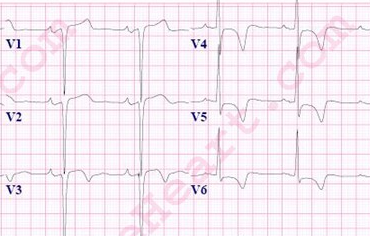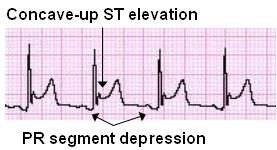Topic Reviews A-Z
Diagnosis - STEMI
Diagnosis – CAD - STEMI
The diagnosis of STEMI is primarily based on the clinical presentation, the 12-lead ECG and laboratory measurement of specific cardiac enzymes that are released with the significant myocardial necrosis occurring in the setting of STEMI.
Cardiac enzymes — also known as cardiac biomarkers — include myoglobin, troponin and creatine kinase (historically, lactate dehydrogenase (LDH) was also used; however, LDH is nonspecific).
Myoglobin
Myoglobin is released into circulation with any damage to muscle tissue, including myocardial necrosis. Because both cardiac and skeletal muscle contain myoglobin, elevations of myoglobin are not specific for MI. However, an increase in serum myoglobin can be detected early — only 30 minutes after injury occurs — in contrast to troponins and creatine kinase, which may take 3 to 4 hours to rise to detectable levels.
Troponin
The enzymes troponin I and troponin T are proteins with important roles in the contractile apparatus of the cardiac myocyte. The troponins are released into the circulation about 3 to 4 hours after the onset of MI and can be detected for up to 10 days afterwards. The long half-life allows for late diagnosis of MI but makes it difficult to detect reinfarction (for example, with acute stent thrombosis after PCI). Although there are a number of causes for troponin elevation unrelated to MI, troponin elevation is much more sensitive and specific than myoglobin and creatine kinase.
Creatine Kinase
Creatine kinase (CK), also known as creatine phosphokinase (CPK), is a muscle enzyme that has several isoenzymes. The MB isoform is specific to myocardial cells, whereas MM and BB are specific to skeletal muscle and brain, respectively. The MB-CK level increases approximately 3 to 4 hours after a MI and may remain elevated for 3 to 4 days. This makes it useful for the detection of re-infarction in the 4- to 10-day window after the initial insult. This contrasts with troponin, which remains elevated for 10 days.
ECG findings
ST segment elevations have several different patterns with STEMI and there are also some noncardiac causes of ST segment elevation that ECG readers need to recognize. Importantly, the finding of new left bundle branch block is considered equivalent to STEMI.
The first ECG change during STEMI is the appearance of “hyperacute T waves” — T waves that appear peaked and are related to localized hyperkalemia. These changes are rarely detected, as they are transient and frequently occur prior to hospital arrival. The tracing below shows hyperacute T-wave changes in the anterior leads.
The pattern of ECG changes in STEMI reflects the anatomy of coronary arteries. LAD occlusion produces ST elevation primarily in the precordial (V1-3) leads. Right coronary occlusion produces primary ST changes in the inferior leads in the frontal plane (II-III-AVF), and left circumflex occlusions manifest with ST elevation in the lateral leads (I, AVL and V5-6). Because of the variability of individual coronary anatomy, these patterns are generalizations, not hard and fast rules. ST segment elevation of at least 1 mm in two contiguous leads is required to diagnose STEMI, but there are two major exceptions:
1. The American College of Cardiology/American Heart Association definition of STEMI sets the following criteria: Anterior STEMI requires 2 mm of ST segment elevation in V2 and V3 in men aged 40 years and older; 2.5 mm in men younger than 40 years; and 1.5 mm in women regardless of age. (Thygesen 2018;22a)
Below is an ECG with changes of an acute anterio-lateral infarct with ST-elevation in V1-V4 as well as I and AVL:
2. Posterior STEMI, usually associated with occlusion of an anatomically dominant right coronary artery, may present with ST segment depression in V1 to V3 instead of elevation, because the ST elevation vectors are oriented away from (ie, negative in) the anterior chest leads.
ECG findings of an acute posterior wall MI may include the following:
- New horizontal or downsloping ST-depression of 0.5 mm or more in two contiguous anterior precordial leads and/or T-inversion greater than 1 mm in two contiguous leads with prominent R wave or R/S ratio > 1. (Thygesen 2018;22a).
- R/S wave ratio greater than 1 in leads V1 or V2.
- ST segment elevation in the posterior leads (leads V7-V9).
- Associated ST segment elevation in the inferior leads (II, III and aVF).
Below is an ECG of an infero-posterior STEMI:
Below are ECG examples of STEMI in differing regions.
Anterior wall MI
- Anterior Wall ST Segment Elevation Myocardial Infarction (MI) ECG (Example 1)
- Anterior Wall ST Segment Elevation Myocardial Infarction (MI) ECG (Example 2)
- Anterior Wall ST Segment Elevation Myocardial Infarction (MI) ECG (Example 3)
- Anterior Wall ST Segment Elevation Myocardial Infarction (MI) ECG (Example 4)
- Anterior Wall ST Segment Elevation Myocardial Infarction (MI) ECG (Example 5)
- Anterior Wall ST Segment Elevation Myocardial Infarction (MI) ECG (Example 6)
- Anterior Wall ST Segment Elevation Myocardial Infarction (MI) with RBBB ECG (Example 1)
- Anterior Wall ST Segment Elevation Myocardial Infarction (MI) with RBBB ECG (Example 2)
- Old Anterior Wall Myocardial Infarction (MI) ECG
Inferior wall MI
- Inferior Wall Myocardial Infarction (MI) ECG (Example 1)
- Inferior Wall Myocardial Infarction (MI) ECG (Example 2)
- Inferior Wall Myocardial Infarction (MI) ECG (Example 3)
- Inferior Wall Myocardial Infarction (MI) ECG (Example 4)
- Inferior Wall Myocardial Infarction (MI) ECG (Example 5)
- Inferior Wall Myocardial Infarction (MI) ECG (Example 6)
- Inferior Wall Myocardial Infarction (MI) with RBBB ECG (Example 1)
- Inferior Wall Myocardial Infarction (MI) with RBBB ECG (Example 2)
- Normal Inferior Q Waves - not Old Inferior Wall Myocardial Infarction (MI) ECG
- Old Inferior Wall Myocardial Infarction (MI) ECG (Example 1)
- Old Inferior Wall Myocardial Infarction (MI) ECG (Example 2)
Posterior wall MI
- Inferior-Posterior Wall Myocardial Infarction (MI) ECG (Example 1)
- Inferior-Posterior Wall Myocardial Infarction (MI) ECG (Example 2)
- Inferior-Posterior Wall Myocardial Infarction (MI) ECG (Example 3)
- Inferior-Posterior Wall Myocardial Infarction (MI) - Right-Sided ECG
- Posterior Wall Myocardial Infarction (MI) - Standard ECG
- Posterior Wall Myocardial Infarction (MI) - Posterior ECG
Differential diagnosis of ST elevation
A good mnemonic for the causes of ST segment elevation on an ECG is “ELEVATION.”
Electrolyte abnormalities
Left bundle branch block
Early repolarization
Ventricular hypertrophy
Arrhythmia disease (Brugada syndrome, ventricular tachycardia)
Takotsubo/Treatment
Injury/Infection (pericarditis or cardiac contusion)
Osborne waves (hypothermia or hypocalcemia)
Nonatherosclerotic (vasospasm or angina)
The four most common causes of ST segment elevation that may mimic STEMI are reviewed here:
1. Left ventricular hypertrophy
When left ventricular hypertrophy (LVH) is present, the voltage on the 12-lead ECG is frequently increased; however, ST segment changes can also occur with LVH, mimicking STEMI or ischemic ST segment depressions. This is referred to as “LVH with strain” or “LVH with repolarization abnormality.” Distinguishing these changes from those during STEMI is important, though often difficult. The typical pattern with LVH includes deviation of the ST segment in the opposite direction of the QRS complex (discordance), along with a typical T wave inversion pattern.
2. Early repolarization
Early repolarization is not uncommon in younger individuals. Early repolarization is seen more frequently in Black males and in athletes. There is J-point elevation and upsloping ST segment elevation that may be diffuse but is generally more prominent in the precordial leads. (Casado Arroyo 2018;2a).
3. Pericarditis
Pericardial inflammation is associated with ST elevation. Initially in pericarditis there is diffuse concave upward ST segment elevation in most leads. Subtle PR depression may also occur inmost leads. Finally, notching at the end of the QRS complex may occur; see Pericarditis ECG Review for more details.
4. Left ventricular aneurysm
ST segment elevation that persists more than 2 weeks after MI is associated with a focal wall motion disorder (“ventricular aneurysm”). If previous ECGs are not available for comparison, these persistent ECG changes may appear similar to STEMI ECG findings. The persistent ST segment elevation appears in the precordial leads with an anterior or apical aneurysm and in II-III-AVF with an inferior aneurysm.
References:
- Bouma W, et al. J Cardiothorac Surg. 2014;doi:10.1186/s13019-014-0171-z.
- Braunwald’s Heart Disease: A Textbook of Cardiovascular Medicine. 2011; 9th edition
- Casado Arroyo R, et al. Front Cardiovasc Med. 2018;doi:10.3389/fcvm.2018.00161.
- DeFilippis AP, et al. Circulation. 2019;doi:10.1161/CIRCULATIONAHA.119.040631.
- Elbadawi A, et al. JACC Cardiovasc Interv. 2019;doi:10.1016/j.jcin.2019.04.039.
- Gorter TM, et al. Am J Cardiol. 2016;doi:10.1016/j.amjcard.2016.05.006.
- Goyal A, et al. Contemporary Management of Post-MI Ventricular Septal Rupture. www.acc.org/latest-in-cardiology/articles/2018/07/30/06/58/contemporary-management-of-post-mi-ventricular-septal-rupture. Published July 30, 2018. Accessed June 8, 2022.
- Grundy SM, et al. J Am Coll Cardiol. 2019;doi:10.1016/j.jacc.2018.11.003.
- Haji SA, et al. Clin Cardiol. 2000;doi:10.1002/clc.4960230721.
- Harjola VP, et al. Eur J Heart Fail. 2016;doi:10.1002/ejhf.478.
- Hurst’s the Heart; 2017, 14th Edition
- Jernberg T, et al; Circulation. 2018;doi:10.1161/CIRCULATIONAHA.118.036220.
- Lador A, et al. Am J Cardiol. 2018;doi:10.1016/j.amjcard.2017.12.006.
- Kumar A, et al. Mayo Clin Proc. 2009;doi:10.4065/84.10.917.
- O’Gara P, et al. J Am Coll Cardiol. 2013;doi:10.1016/j.jacc.2012.11.019.
- Pokorney SD, et al. J Atr Fibrillation. 2012;doi:10.4022.jafib.611.
- Rezkalla SH, et al. JACC Cardiovasc Interv. 2017;doi:10.1016/j.jcin.2016.11.059.
- Taleb I, et al. Circulation. 2019;doi:10.1161/CIRCULATIONAHA.119.040654.
- Tehrani BN, et al. JACC Heart Fail. 2020;doi:10.1016/j.jchf.2020.09.005.
- Thygesen K, et al; Circulation. 2018;doi:10.1161/CIR.0000000000000617.







